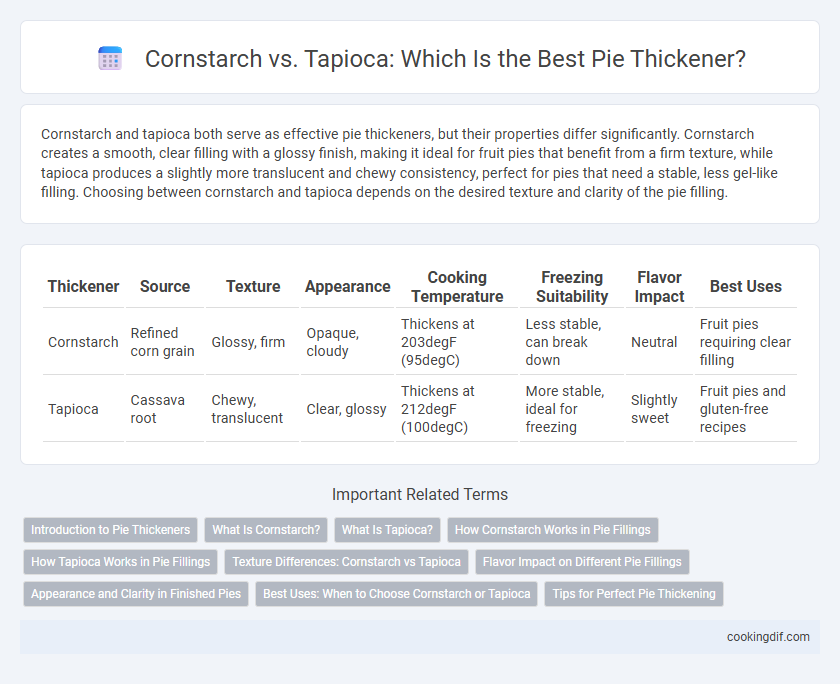Cornstarch and tapioca both serve as effective pie thickeners, but their properties differ significantly. Cornstarch creates a smooth, clear filling with a glossy finish, making it ideal for fruit pies that benefit from a firm texture, while tapioca produces a slightly more translucent and chewy consistency, perfect for pies that need a stable, less gel-like filling. Choosing between cornstarch and tapioca depends on the desired texture and clarity of the pie filling.
Table of Comparison
| Thickener | Source | Texture | Appearance | Cooking Temperature | Freezing Suitability | Flavor Impact | Best Uses |
|---|---|---|---|---|---|---|---|
| Cornstarch | Refined corn grain | Glossy, firm | Opaque, cloudy | Thickens at 203degF (95degC) | Less stable, can break down | Neutral | Fruit pies requiring clear filling |
| Tapioca | Cassava root | Chewy, translucent | Clear, glossy | Thickens at 212degF (100degC) | More stable, ideal for freezing | Slightly sweet | Fruit pies and gluten-free recipes |
Introduction to Pie Thickeners
Cornstarch and tapioca are popular pie thickeners that impact texture and clarity of fruit fillings. Cornstarch creates a glossy, firm filling but can break down if overcooked, while tapioca provides a more translucent, slightly gelled consistency ideal for mixed fruit pies. Choosing the right thickener depends on desired firmness, clarity, and cooking method to achieve the perfect pie consistency.
What Is Cornstarch?
Cornstarch is a fine, white powder derived from the endosperm of corn kernels, commonly used as a thickening agent in pie fillings. It creates a glossy, translucent finish and thickens quickly when heated, offering a smooth texture without altering the flavor. Unlike tapioca, which forms a more chewy consistency, cornstarch provides a clean, stable thickening ideal for fruit pies like apple or cherry.
What Is Tapioca?
Tapioca is a starch extracted from the cassava root, frequently used as a thickening agent in pie fillings due to its ability to create a clear, glossy texture and resist breakdown during freezing. Unlike cornstarch, tapioca provides a chewier consistency and maintains stability at higher temperatures, making it ideal for fruit pies with juicy fillings. Its fine granules activate quickly and impart a neutral flavor, enhancing the pie's natural taste without adding cloudiness.
How Cornstarch Works in Pie Fillings
Cornstarch thickens pie fillings by absorbing liquid and swelling upon heating, creating a smooth, glossy texture that sets as it cools. Its fine granules gelatinize at around 203degF (95degC), effectively thickening fruit juices and preventing separation. Cornstarch provides a clear, stable consistency ideal for clear fruit pies, offering a firmer, more gel-like structure compared to tapioca.
How Tapioca Works in Pie Fillings
Tapioca functions as a thickener in pie fillings by forming a clear, glossy gel when heated, which enhances the texture without clouding the filling. Its unique ability to absorb and trap liquid prevents separation and weeping, providing a stable and smooth consistency. Unlike cornstarch, tapioca maintains its thickening power even after freezing and thawing, making it ideal for fruit pies.
Texture Differences: Cornstarch vs Tapioca
Cornstarch creates a smooth, glossy texture in pie fillings with a thick consistency that sets firmly as it cools, ideal for fruit pies requiring clear, gel-like surfaces. Tapioca produces a slightly chewier and more translucent filling, offering a subtle bounce and a more natural, rustic appearance due to its larger starch granules. Choosing between cornstarch and tapioca depends on the desired mouthfeel and visual appeal, with cornstarch delivering a sleek finish and tapioca providing a heartier texture.
Flavor Impact on Different Pie Fillings
Cornstarch creates a neutral flavor that allows pie fillings like apple or cherry to maintain their natural taste, while tapioca imparts a slightly sweet and glossy finish, enhancing fruit pies such as blueberry or mixed berry. Tapioca's mild flavor can complement fillings with subtle spices or tropical fruits, whereas cornstarch works well with creamy or custard pies where a clean taste is preferred. Choosing between cornstarch and tapioca depends on the desired balance between thickening power and flavor elevation in various pie recipes.
Appearance and Clarity in Finished Pies
Cornstarch creates a glossy, clear finish in pies, providing a smooth and translucent filling that enhances the pie's visual appeal. Tapioca tends to produce a slightly more opaque and gel-like texture, offering a rustic, less shiny appearance. For a polished, clear look in fruit pies, cornstarch is the preferred thickener due to its superior clarity.
Best Uses: When to Choose Cornstarch or Tapioca
Cornstarch is best suited for clear fruit pies like cherry or apple, where it provides a glossy finish and firm set without altering the flavor. Tapioca works well in more rustic pies such as berry or peach, offering a slightly chewier texture and better freeze-thaw stability. Choosing between cornstarch and tapioca depends on the desired pie consistency and the fruit's moisture content.
Tips for Perfect Pie Thickening
Cornstarch provides a glossy finish and strong thickening power, ideal for fruit pies that require clear, firm filling, while tapioca creates a slightly chewy texture and handles longer baking times without breaking down. Use 1 tablespoon of cornstarch or 2 tablespoons of tapioca per cup of liquid to achieve optimal consistency, adjusting based on fruit juice acidity and moisture content. For flawless pie thickening, mix cornstarch with cold water before cooking and soak tapioca pearls to ensure even thickening throughout the filling.
Cornstarch vs tapioca for pie thickeners Infographic

 cookingdif.com
cookingdif.com